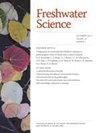Macroinvertebrate ecosystem engineering affects streambed retention of microplastics
IF 1.6
4区 环境科学与生态学
Q3 ECOLOGY
引用次数: 0
Abstract
Microplastic pollution of aquatic environments threatens human health, ecosystem processes, and biodiversity. Many existing models of microplastic movement in streams do not account for biotic effects on microplastic fate. Ecosystem engineering by net-spinning caddisflies (Hydropsychidae) has been shown to substantially affect sediment and organic matter transport as well as streambed hydrology. Caddisfly engineering may likewise affect the movement of microplastic pollution in streams. We used a controlled 11-d flume experiment to investigate the potential for caddisflies to serve as a biotic control on microplastic transport. Flumes containing a single gravel dune were randomly assigned to density treatments: control (0 caddisflies/m2) or stocked with 500, 800, or 2500 caddisflies/m2, incubated (d 1–10) to allow for caddisfly silk structure construction, inoculated (d 11) with PVC microplastics (333 µm–1 mm), and sampled (d 12). Microplastic was quantified as caught in a drift net (downstream transport), eaten by caddisflies (ingestion), or captured in caddisfly silk structures or settled into the gravel dune (i.e., total streambed retention). Mean downstream plastic transport was 9% lower than the control in the 800 caddisflies/m2 treatment (p < 0.001) and 10% lower in the 2500 caddisflies/m2 treatment (p = 0.003). Mean total streambed retention was 9% higher than the control in the 800 caddisflies/m2 treatment (p < 0.001) and 10% higher in the 2500 caddisflies/m2 treatment (p = 0.004). Ingestion of plastic by caddisflies was rare and highly variable (0–0.55% of plastic particles) but did increase with caddisfly density (p = 0.002). This work represents one of the first investigations of animal ecosystem engineering as a control on the movement and fate of microplastic particles in fresh waters and establishes a foundation for future research on biotic control of microplastic transport. Our results suggest that ecosystem engineering by net-spinning caddisflies may serve as a biotic control of microplastic transport in freshwater streams.大型无脊椎动物生态系统工程影响微塑料的河床滞留
水生环境的微塑料污染威胁着人类健康、生态系统过程和生物多样性。许多现有的微塑料在溪流中运动的模型没有考虑到生物对微塑料命运的影响。已证明,通过旋转网球藻(水螅科)进行的生态系统工程会对沉积物和有机物的运输以及河床水文产生重大影响。Caddisfly工程同样可能影响微塑料污染在溪流中的移动。我们使用了一个可控的11-d水槽实验来研究球藻作为微塑料运输的生物控制的潜力。将含有单个砾石沙丘的水槽随机分配到密度处理中:对照(0球童/m2)或储存500、800或2500球童/m2,孵育(第1-10天)以构建球童丝结构,用PVC微塑料(333µm–1 mm)接种(第11天),并取样(第12天)。微塑料被量化为被流网捕获(下游运输)、被球藻吃掉(摄入)、或被球藻丝结构捕获或沉降到砾石沙丘中(即总河床滞留量)。平均下游塑料输送量在800 caddisflies/m2处理中比对照组低9%(p<0.001),在2500 caddisflies/m2处理中低10%(p=0.003高度可变(塑料颗粒的0–0.55%),但确实随着密度的增加而增加(p=0.002)。这项工作代表了动物生态系统工程作为控制微塑料颗粒在淡水中运动和命运的第一项研究之一,并为未来研究微塑料运输的生物控制奠定了基础。我们的研究结果表明,通过旋转球笼进行的生态系统工程可以作为淡水流中微塑料运输的生物控制。
本文章由计算机程序翻译,如有差异,请以英文原文为准。
求助全文
约1分钟内获得全文
求助全文
来源期刊

Freshwater Science
ECOLOGY-MARINE & FRESHWATER BIOLOGY
CiteScore
4.10
自引率
0.00%
发文量
49
审稿时长
6-12 weeks
期刊介绍:
Freshwater Science (FWS) publishes articles that advance understanding and environmental stewardship of all types of inland aquatic ecosystems (lakes, rivers, streams, reservoirs, subterranean, and estuaries) and ecosystems at the interface between aquatic and terrestrial habitats (wetlands, riparian areas, and floodplains). The journal regularly features papers on a wide range of topics, including physical, chemical, and biological properties of lentic and lotic habitats; ecosystem processes; structure and dynamics of populations, communities, and ecosystems; ecology, systematics, and genetics of freshwater organisms, from bacteria to vertebrates; linkages between freshwater and other ecosystems and between freshwater ecology and other aquatic sciences; bioassessment, conservation, and restoration; environmental management; and new or novel methods for basic or applied research.
 求助内容:
求助内容: 应助结果提醒方式:
应助结果提醒方式:


